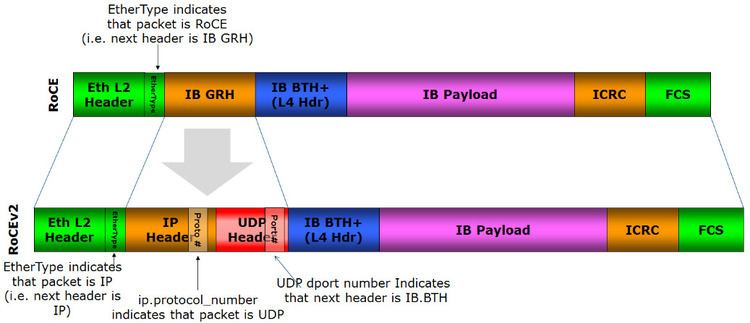 | ||
RDMA over Converged Ethernet (RoCE) is a network protocol that allows remote direct memory access (RDMA) over an Ethernet network. There are two RoCE versions, RoCE v1 and RoCE v2. RoCE v1 is an Ethernet link layer protocol and hence allows communication between any two hosts in the same Ethernet broadcast domain. RoCE v2 is an internet layer protocol which means that RoCE v2 packets can be routed. Although the RoCE protocol benefits from the characteristics of a converged Ethernet network, the protocol can also be used on a traditional or non-converged Ethernet network.
Contents
Background
Network-intensive applications like networked storage or cluster computing need a network infrastructure with a high bandwidth and low latency. The advantages of RDMA over other network application programming interfaces such as Berkeley sockets are lower latency, lower CPU load and higher bandwidth. The RoCE protocol allows lower latencies than its predecessor, the iWARP protocol. There exist RoCE HCAs (Host Channel Adapter) with a latency as low as 1.3 microseconds while the lowest known iWARP HCA latency in 2011 was 3 microseconds.
RoCE v1
The RoCE v1 protocol is an Ethernet link layer protocol with ethertype 0x8915. This means that the frame length limits of the Ethernet protocol apply - 1500 bytes for a regular Ethernet frame and 9000 bytes for a jumbo frame.
RoCE v2
The RoCEv2 protocol exists on top of either the UDP/IPv4 or the UDP/IPv6 protocol. The UDP destination port number 4791 has been reserved for RoCE v2. Since RoCEv2 packets are routable the RoCE v2 protocol is sometimes called Routable RoCE or RRoCE. Although in general the delivery order of UDP packets is not guaranteed, the RoCEv2 specification requires that packets with the same UDP source port and the same destination address must not be reordered. In addition, RoCEv2 defines a congestion control mechanism that uses the IP ECN bits for marking and CNP frames for the acknowledgment notification. Software support for RoCE v2 is still emerging. Mellanox OFED 2.3 or later has RoCE v2 support and also Linux Kernel v4.5.
RoCE versus InfiniBand
RoCE defines how to perform RDMA over Ethernet while the InfiniBand architecture specification defines how to perform RDMA over an InfiniBand network. RoCE was expected to bring InfiniBand applications, which are predominantly based on clusters, onto a common Ethernet converged fabric. Others expected that InfiniBand will keep offering a higher bandwidth and lower latency than what is possible over Ethernet.
The technical differences between the RoCE and InfiniBand protocols are:
RoCE versus iWARP
While the RoCE protocols define how to perform RDMA using Ethernet and UDP/IP frames, the iWARP protocol defines how to perform RDMA over a connection-oriented transport like the Transmission Control Protocol (TCP). RoCE v1 is limited to a single Ethernet broadcast domain. RoCE v2 and iWARP packets are routable. The memory requirements of a large number of connections along with TCP's flow and reliability controls lead to scalability and performance issues when using iWARP in large-scale datacenters and for large-scale applications (i.e. large-scale enterprises, cloud computing, web 2.0 applications etc.). Also, multicast is defined in the RoCE specification while the current iWARP specification does not define how to perform multicast RDMA.
Criticism
Some aspects that could have been defined in the RoCE specification have been left out. These are:
